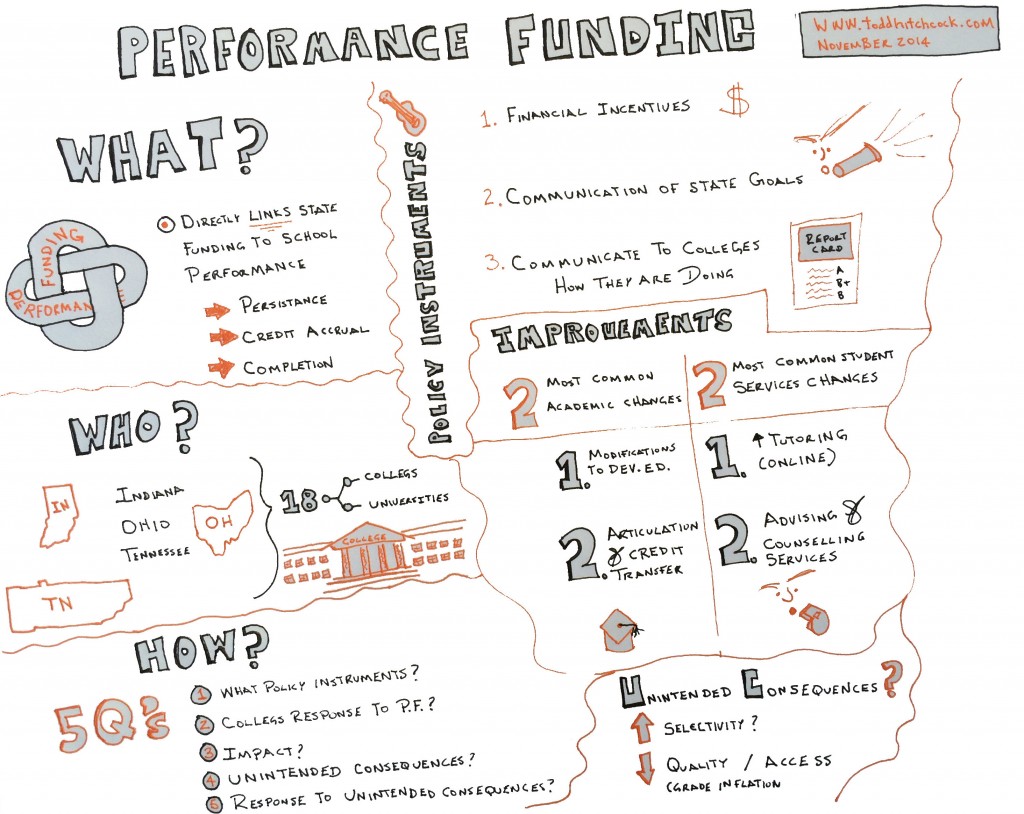I will start by saying I am a big believer in performance funding models in education. Maybe it is due to my time working with Julie Young at Florida Virtual or maybe it is because I am a big goal setter – both in my personal life and work life. Without clearly defined goals and objectives, maximum potential cannot be achieved.
| Performance Funding directly connects state funding to an institution’s performance focusing on areas such as student persistence, credit accrual and college completion. |
Earlier this month the Community College Research Center (CCRC) released ‘Implementing Performance Funding in Three Leading States: Instruments, Outcomes, Obstacles, and Unintended Impacts‘. The research focused on 18 colleges and universities in three states where performance funding models have been implemented (Ohio, Indiana, and Tennessee).
The research revolved around five key questions:
1. What policy instruments have states used to influence the behavior of institutions?
2. In what ways have colleges & universities responded to performance funding policy?
3. What impact has performance funding made on student outcomes?
4. Have there been unintended consequences of performance funding?
5. How have states responded to obstacles and unintended impacts?
Check out my visual representation below:
A number of different policy instruments were identified but three had been implemented:
– Financial Incentives
– Disseminating Information about the goals and methods of performance funding
– Communicating to colleges how they are doing on state performance funding metrics (i.e. a report card)
– Building up institutional capacity to respond to performance funding
Of these, Financial Incentives are the biggest motivator (this could be a result of the goals of performance funding not being disseminated beyond college & university leadership – i.e. down into the organization).
FINANCIAL INCENTIVES
The objective for using financial incentives is to persuade colleges & universities to focus on student outcomes with funding being allocated directly to performance. The %age of funding associated to performance funding varied across the three states that were studied

With Financial Incentives, special audiences can be targeted with additional funding (low-income families, race/ethnicity, and age).
The research found that college and university leaders are ‘following the money‘ and working to aligning practices to improve student outcomes – as the student’s performance now have an impact on the bottom line – with performance funding models in place.
Paradoxically, the financial incentives are making a substantial impact on the schools’ efforts to improve student outcomes BUT these incentives are not making a material impact on the school’s budget.
| Tot date, it is impossible to associate any institutional gains in any area directly to performance funding – given there are always multiple initiatives (in addition to performance funding) running concurrently. Deeper multivariate research is required to directly correlate improvements in student learning outcomes to performance funding. That is, while performance funding has resulted in a focus on improving student performance, it cannot be empirically tied directly to gains. |
CHANGES IN ACADEMIC POLICIES, PROGRAMS, AND PRACTICE
The two most common academic changes that schools are making following the implementation of performance funding models are:
1. Modifications to Developmental Education Programs (for more on this, see my post on ‘Hacking Remedial Education‘)
2. Development of / Stronger Course Articulation and Transfer (N.B. The focus was on transfer of credits from a two-year school to a four-year school, similarly to the 2+2 model in place in Florida. That noted, in this study there was no focus on transfer of credits between institutions. This may be a flaw in the system given the demographic of students now attending college/university and the fact that a significant percentage of them have accumulated credits from different institutions).
CHANGES IN STUDENT SERVICES
The two most common changes to student services that schools are making following the implementation of performance funding models are:
1. Increased focus on advising and counselling (i.e. additional advisors, adding online advising, developing early alert / early warning systems)
2. Addition / bolstering of tutoring and supplemental instruction (i.e. addition of tutoring, online tutoring, and requirements for faculty to meet with students 1:1)
UNINTENDED CONSEQUENCES
While there is no evidence of this, two unintended consequences identified by the 18 colleges & universities studied are:
1. Given performance funding models are based on school’s increasing overall student performance, there is potential for ‘creaming‘ – i.e. increasing admission requirements and/or only selecting stronger students. Given these were ‘open enrollment’ schools, it was feared that this could pull them away from their core mission and result in fewer students being enrolled.
2. Decrease in academic quality (i.e. the ‘easy A‘)
Ultimately though, the professionalism of the faculty and administration is likely to mitigate these risks.
FINAL THOUGHT
With performance funding models now prevalent in 30 states and many more on the way in the coming years, it is clear that university administrators are embracing the model – and accepting the challenge. Ultimately, any and all models that are putting more focus on helping individual students persist are valuable. Performance funding has a strong probability of having a major impact.
